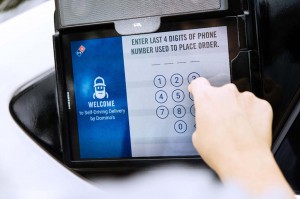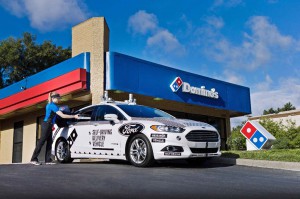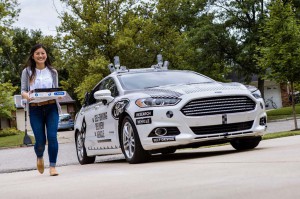Ford and Domino’s are teaming up to test out the idea of using autonomous vehicles for home delivery of the fast food chain’s pizzas. The project, which will be run in Domino’s hometown of Ann Arbor, Michigan, is aimed at gaining insight into how hungry customers will react when a delivery truck shows up without a driver behind the wheel.
On the plus side, there’ll be no tipping. And customers will learn when their pizza’s delivered by text, rather than a ring of the doorbell. But that means they’ll have to go outside and punch a code into keypad to retrieve their hot pies.
“The majority of our questions” that Domino’s has been fielding about the service “are about the last 50 feet of the delivery experience,” said Domino’s President Russell Weiner.
While driverless deliveries might be welcomed by those in sunny California, the question is how customers will respond when they have to get dressed up to go outside in a Michigan snowstorm, or even in the heavy rains that hit the region on Tuesday night.
(Uber makes surprise pick for CEO. To see whom the board selected, Click Here.)
Domino’s interest in driverless delivery should be no surprise. The vast majority of its sales – about 1 billion pizza pies annually – must be delivered to customers’ homes or offices. The second-largest pizza chain in the world, with global sales of around $10.9 billion in 2016, the company says its drivers clock about 10 million miles a week. Even at minimum wage, the 100,000 drivers it uses in the U.S. alone weigh heavily on the company’s bottom line.

Customers must punch a code into a keypad on the delivery vehicle to get their order from the heated storage area on the vehicle.
Domino’s has been looking at other alternatives to take drivers out of the equation, including drone delivery.
The driverless test will run for six weeks, taking it into cooler autumn weather, but not into a Michigan winter.
Deliveries will be made by a specially outfitted Ford Fusion using radar, cameras and high-definition laser devices, called LIDAR, as well as highly detailed 3D maps. Technically, there actually will be a person behind the wheel of the prototype delivery vehicles – a Ford engineer monitoring the operation of the test cars. But the windows of the vehicles will be blacked out and there will be no direct interaction with customers.
Instead, once the customer receives a text alert they will be asked to go outside and punch a code into a keypad mounted on the car. That will open up a rear window allowing them to reach inside and remove their order. Each vehicle is equipped with a heated compartment that can carry up to four pizzas and five side dishes.
(Click Here for details about Waymo’s ongoing testing program.)
“We’re developing a self-driving car not just for the sake of technology,” said Sherif Marakby, the vice president in charge of Ford’s autonomous and electric vehicle program. “There are so many practical things that we need to learn.”
Ford last year announced plans to launch production of its first fully driverless vehicle in 2021, emphasizing that it will target fleet users, rather than retail customers. It is already rolling out a phalanx of autonomous prototypes, like the Fusion models Domino’s is using, to help develop its technology. The second-largest domestic automaker said it plans to work “with multiple partners” on similar projects that will be “designed to improve the movement of people and goods.”
Ford and Domino’s are by no means the only ones interested in commercial applications for autonomous and fully driverless vehicles:
- Waymo, the Google spinoff, is currently testing its self-driving technology in the Phoenix area, using specially modified Chrysler Pacifica Hybrid minivans for a ride-sharing pilot program.
- Uber is running a similar test in Phoenix, Pittsburgh and several other cities around the U.S.;
- The ride-sharing giant’s chief rival, Lyft, has just launched its own driverless research program.
Ride-sharing services, like restaurants and other home delivery firms, are especially interested in pulling drivers out of their vehicles. Drivers are, in fact, the single-largest budget line item for Uber and Lyft. Former Uber CEO Travis Kalanick estimated that by switching to driverless vehicles his company could drop the price of a ride to the point where it would be cheaper to ride-share than own a private automobile.
Firms like Domino’s, as well as delivery services like UPS, do face the last-50-foot challenge, however, especially in inclement weather or when dealing with large, cumbersome packages.
(To see more about Lyft doubling its ridership, Click Here.)
As a result, Domino’s will only use the driverless Ford Fusion prototypes to deliver to customers who opt in for the test program. Other Ann Arbor customers will get their pizzas the old-fashioned way – and will still have to come up with money for the tip.


